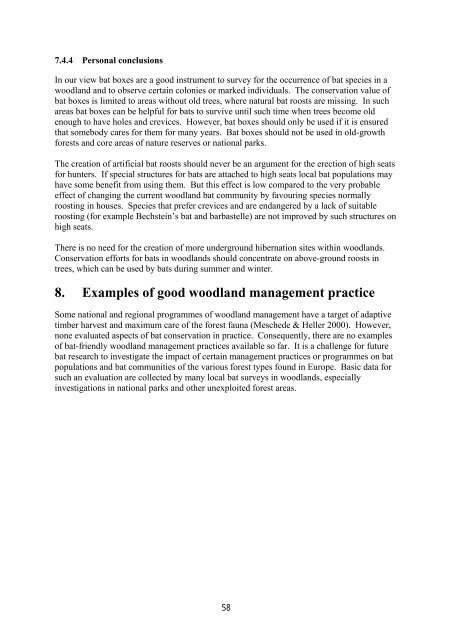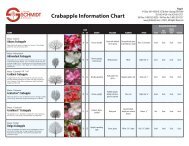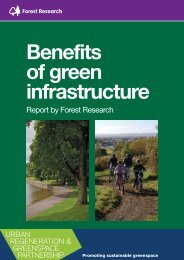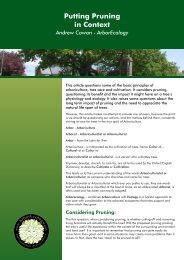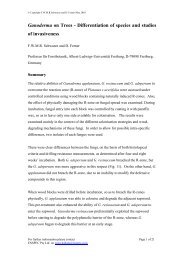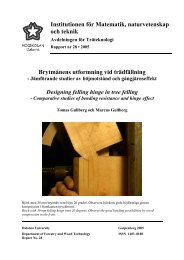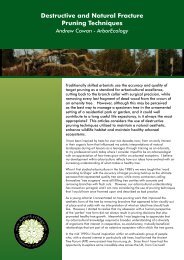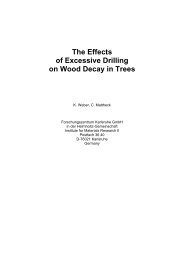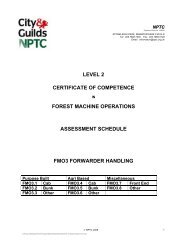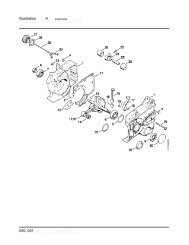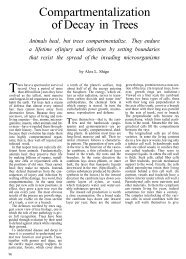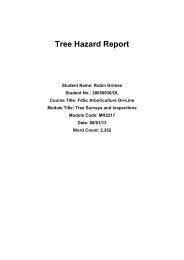7.4.4 Personal conclusionsIn our view bat boxes are a good instrument to survey <strong>for</strong> the occurrence of bat species in awoodland and to observe certain colonies or marked individuals. The conservation value ofbat boxes is limited to areas without old trees, where natural bat roosts are missing. In suchareas bat boxes can be helpful <strong>for</strong> bats to survive until such time when trees become oldenough to have holes and crevices. However, bat boxes should only be used if it is ensuredthat somebody cares <strong>for</strong> them <strong>for</strong> many years. Bat boxes should not be used in old-growth<strong>for</strong>ests and core areas of <strong>nature</strong> reserves or national parks.The creation of artificial bat roosts should never be an argument <strong>for</strong> the erection of high seats<strong>for</strong> hunters. If special structures <strong>for</strong> bats are attached to high seats local bat populations mayhave some benefit from using them. But this effect is low compared to the very probableeffect of changing the current woodland bat community by favouring species normallyroosting in houses. Species that prefer crevices and are endangered by a lack of suitableroosting (<strong>for</strong> example Bechstein’s bat and barbastelle) are not improved by such structures onhigh seats.There is no need <strong>for</strong> the creation of more underground hibernation sites within woodlands.Conservation ef<strong>for</strong>ts <strong>for</strong> bats in woodlands should concentrate on above-ground roosts intrees, which can be used by bats during summer and winter.8. Examples of good woodland management practiceSome national and regional programmes of woodland management have a target of adaptivetimber harvest and maximum care of the <strong>for</strong>est fauna (Meschede & Heller 2000). However,none evaluated aspects of bat conservation in practice. Consequently, there are no examplesof bat-friendly woodland management practices available so far. It is a challenge <strong>for</strong> futurebat research to investigate the impact of certain management practices or programmes on batpopulations and bat communities of the various <strong>for</strong>est types found in Europe. Basic data <strong>for</strong>such an evaluation are collected by many local bat surveys in woodlands, especiallyinvestigations in national parks and other unexploited <strong>for</strong>est areas.58
9. ReferencesABULADZE, A., BUXNIKASHVILI, A., & TARKHNISHVILI, D. 2001. Vertebrateanimals of Borjomi-Kharagauli Nacional Park. Tibilisi: WWF.AHLÉN, I., & BAAGOE, H. J. 2000. Use of ultrasound detectors <strong>for</strong> bat studies in Europe:experiences from field identification, surveys, and monitoring. Acta Chiropterologica, 1,137-150.AHLÉN, I. 1981. Identification of Scandinavian bats by their sounds. Upsala: Departmentof Wildlife Ecology, Swedish University of Agricultural Sciences.ALBRECHT, K., HAMMER, M., & HOLZHAIDER, J. 2002. TelemetrischeUntersuchungen zum Nahrungshabitatanspruch der Bechsteinfledermaus (Myotis bechsteinii)in Nadelwäldern bei Amberg in der Oberpfalz. In: MESCHEDE, A., HELLER, K.-G., &BOYE, P., eds. Ökologie, Wanderungen und Genetik von Fledermäusen in Wäldern –Untersuchungen als Grundlage für den Fledermausschutz, 109-130. Münster(Landwirtschaftsverlag): Schriftenreihe für Landschaftspflege und Naturschutz 71.ALTRINGHAM, J. D. 1996. Bats. Biology and behaviour. Ox<strong>for</strong>d: Ox<strong>for</strong>d UniversityPress.ANTHONY, E. L. P., & KUNZ, T. H. 1977. Feeding strategies of the little brown bat,Myotis lucifugus, in southern New Hampshire. Ecology, 58, 775–786.ARNOLD, A., & BRAUN, M. 2002. Telemetrische Untersuchungen anRauhhautfledermäusen (Pipistrellus nathusii Keyserling & Blasius, 1839) in dennordbadischen Rheinauen. In: MESCHEDE, A., HELLER, K.-G., & BOYE, P., eds.Ökologie, Wanderungen und Genetik von Fledermäusen in Wäldern – Untersuchungen alsGrundlage für den Fledermausschutz, 177-189. Münster (Landwirtschaftsverlag):Schriftenreihe für Landschaftspflege und Naturschutz 71.ARNOLD, A. 1999. Zeit-Raumnutzungsverhalten und Nahrungsökologierheinauenbewohnender Fledermausarten (Mammalia: Chiroptera). University of Heidelberg:PHD thesis.AUDET, D. 1990. Foraging behaviour and habitat use by a gleaning bat, Myotis myotis,(Chiroptera: Vespertilionidae). Journal of Mammalogy , 71, 420-427.AUDET, D. 1992. Roost quality, <strong>for</strong>aging and young production in the mouse-eared batMyotis myotis: A test of the ESS model of group size selection. PHD thesis.BAAGØE, H. 2001. Danish bats (Mammalia: Chiroptera): Atlas and analysis ofdistribution, occurrence and abundance. Steenstrupia, 26, 1-117.BAAGØE, H. J. & JENSEN, B. 1973. The spread and present occurrence of the serotine(Eptesicus serotinus) in Denmark. Period. biol., 75, 107-109.BAAGØE, H. J. 1986. Summer occurrence of Vespertilio murinus Linné 1758 andEptesicus serotinus Schreber 1774 (Chiroptera, Mammalia) on Zealand, Denmark, based on59
- Page 3:
English Nature Research ReportsNumb
- Page 7 and 8: ContentsPreamble1. Legal aspects...
- Page 9 and 10: 1. Legal aspectsThere are three int
- Page 11 and 12: to the Agreement decided that the c
- Page 13 and 14: Country European Community EUROBATS
- Page 15 and 16: types in Europe where many of the e
- Page 17 and 18: • the European Commission initiat
- Page 19 and 20: Foraging areas: Central European sp
- Page 21 and 22: Other roosts: In foraging areas and
- Page 23 and 24: Brandt’s bat travels up to 250 ki
- Page 25 and 26: others 2004). Maternity colonies al
- Page 27 and 28: 1995, The Netherlands: Limpens and
- Page 29 and 30: from a maternity colony covered a t
- Page 31 and 32: hibernaculum is the Levensau Bridge
- Page 33 and 34: female (Fuhrmann and others 2002).
- Page 35 and 36: Foraging areas: In Central Europe f
- Page 37 and 38: Table 2 Importance of tree holes fo
- Page 39 and 40: sites it was found that the possibi
- Page 41 and 42: advancing age of a tree its potenti
- Page 43 and 44: floor up to the canopy and beyond c
- Page 45 and 46: Table 6 Overview of the most freque
- Page 47 and 48: 6.2 2nd step: Active search for roo
- Page 49 and 50: This first approach to a woodland b
- Page 51 and 52: number of tree-dwelling birds in pr
- Page 53 and 54: Types of boxes used by batsThere ar
- Page 55 and 56: oxes exposed to the sun. As an exam
- Page 57: Con: Bats use bat boxes selectively
- Page 61 and 62: BEKKER, J.P. 1990. Ervaringen met v
- Page 63 and 64: BRAUN, M., & HÄUSSLER, U. 2003c. K
- Page 65 and 66: Ökologie und Verbreitung von Arten
- Page 67 and 68: (Germany). In: PRIEDE, I. G. & SWIF
- Page 69 and 70: (Nyctalus leisleri) sowie zur Besie
- Page 71 and 72: HEISE, G. 1985. Zu Vorkommen, Phän
- Page 73 and 74: JONES, G. 1990. Prey selection by t
- Page 75 and 76: (Chiroptera: Vespertilionidae). - P
- Page 77 and 78: Ökologie und Verbreitung von Arten
- Page 79 and 80: PÉREZ, J. L. & IBÁÑEZ, C. 1991.
- Page 81 and 82: ROTTMANN, R., BOYE, P. & MEINIG, H.
- Page 83 and 84: SCHORCHT, W., and others. 2002. Zur
- Page 85 and 86: STUTZ, H.-P. B. & HAFFNER, M. 1989.
- Page 87 and 88: WAGNER, M., KERTH, G. & KÖNIG, B.
- Page 89: 10. AuthorsDr. Peter Boye became fa


